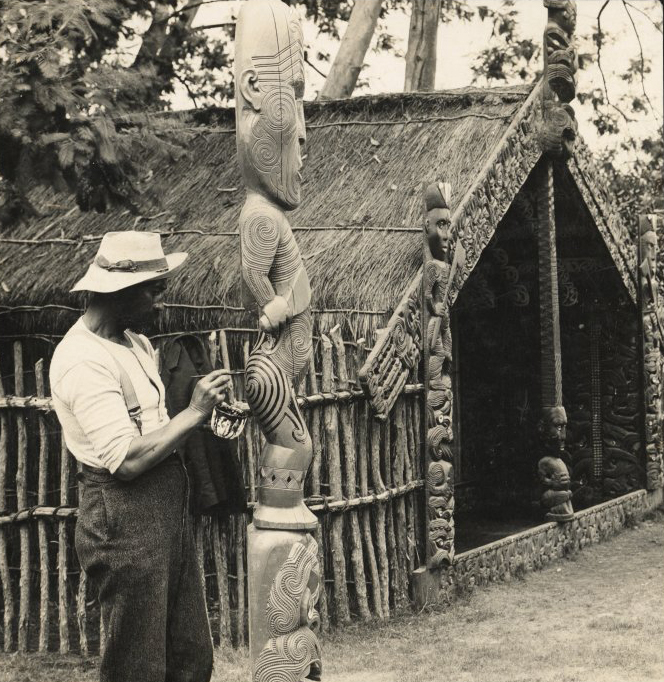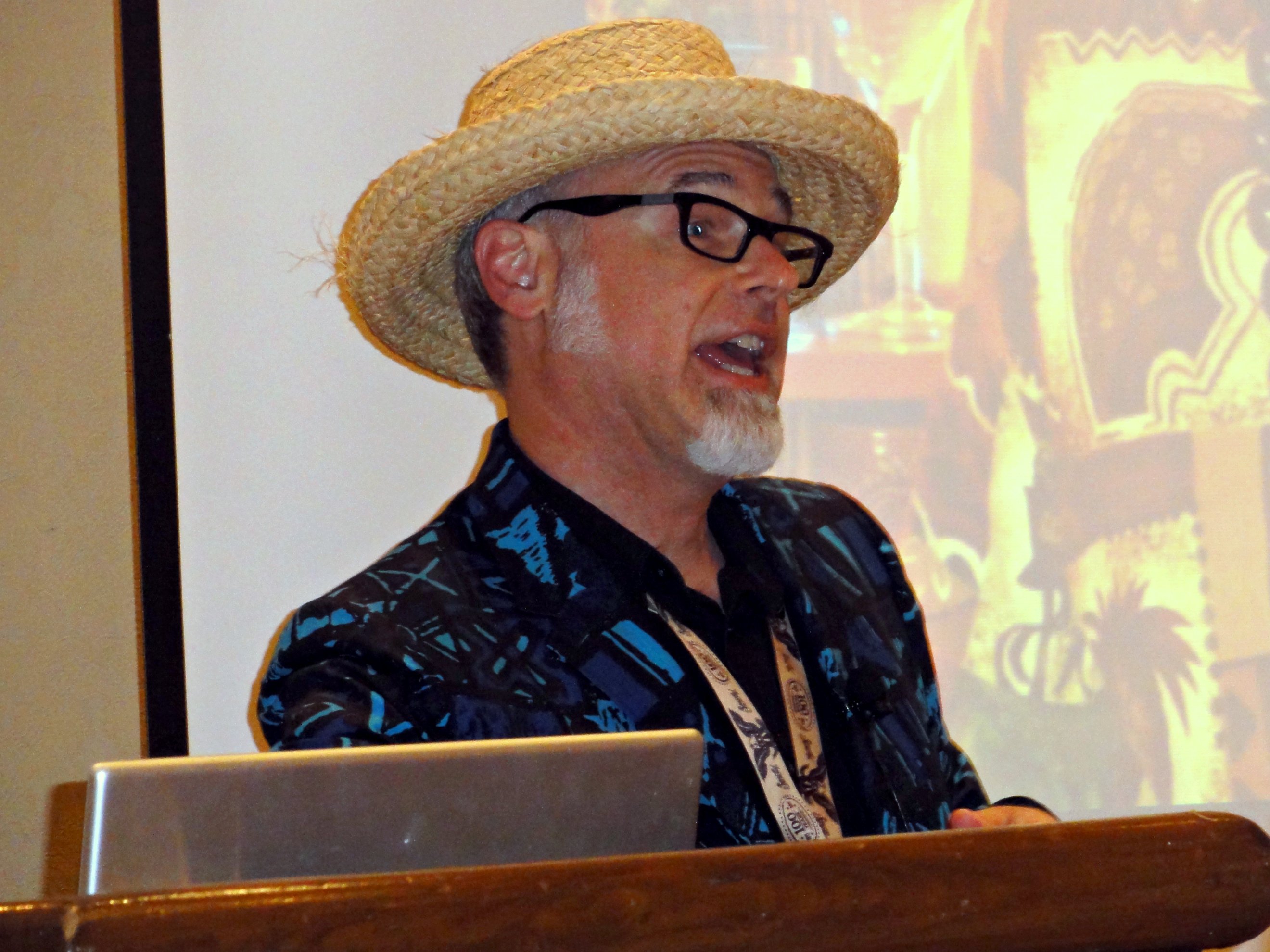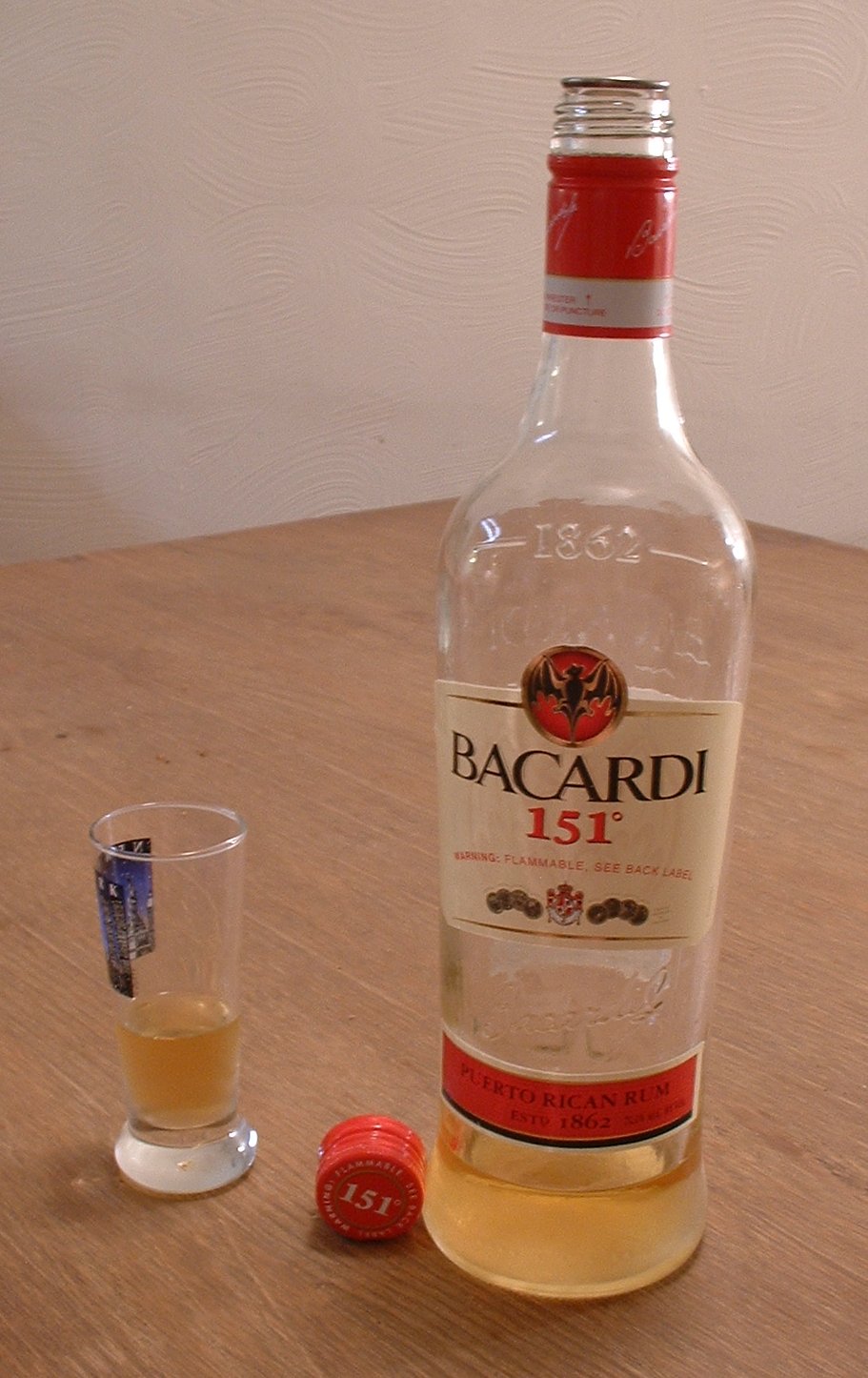|
Tiki Mugs
Tiki mugs are large ceramic cocktail drinking vessels that originated in tiki bars and tropical-themed restaurants. The term "tiki mug" is a blanket term for the sculptural drinkware even though they vary in size and most do not contain handles. They typically depict Polynesian, mock-Polynesian, tropical, nautical, or retro themes, and as the term is used generically do not always emulate a tiki. When used to serve drinks they are frequently garnished with fruit or decorative drink umbrellas and swizzle sticks. Outside of tiki enthusiasts, the mugs are not commonly seen in use beyond tiki bars and restaurants, but some collect them as examples of kitsch. History What many would consider to be the earliest US "tiki mugs" were ceramics in the shape of a skull or an ordinary ceramic vessel with a hula girl-related motif. Mugs meant to emulate a tiki carving, what some would consider to be a "true" tiki mug, did not come to the USA until the late 1950s. A little-known antecedent (a ... [...More Info...] [...Related Items...] OR: [Wikipedia] [Google] [Baidu] |
Tiki Mug From The Purple Orchid Exotic Tiki Lounge
In Māori mythology, Tiki is the first man created by either Tūmatauenga or Tāne. He found the first woman, Marikoriko, in a pond; she seduced him and he became the father of Hine-kau-ataata. By extension, a tiki is a large or small wooden, pounamu or stone carving in humanoid form, notably worn on the neck as a hei-tiki, although this is a somewhat archaic usage in the Māori language. Hei-tiki are often considered taonga, especially if they are older and have been passed down throughout multiple generations. Carvings similar to ngā tiki and coming to represent deified ancestors are found in most Polynesian cultures. They often serve to mark the boundaries of sacred or significant sites. In the Western world, Tiki culture, a movement inspired by various Pacific cultures, has become popular in the 20th and 21st centuries; this has proven controversial, however, as the movement is regarded by many Polynesians as cultural appropriation. Religion In traditions from the West C ... [...More Info...] [...Related Items...] OR: [Wikipedia] [Google] [Baidu] |
Aku-Aku
''Aku-Aku: the Secret of Easter Island'' is a 1957 book by Thor HeyerdahlThor Heyerdahl, ''Aku-Aku: The Secret of Easter Island'', / 9780345238412 / 0-345-23841-9. Hardcover published July 1, 1958 by Rand McNally & Co.; Paperback published 1960 by Penguin Books Limited; Mass market paperback edition May 1961 by Pocket Books, Inc. published in Norwegian, Swedish, Danish and Finnish, and in French and English the following year. The book describes the 1955–1956 Norwegian Archaeological Expedition's investigations of Polynesian history and culture at Easter Island, the Austral Islands of Rapa Iti and Raivavae, and the Marquesas Islands of Nuku Hiva and Hiva Oa. Visits to Pitcairn Island, Mangareva and Tahiti are described as well. By far the greatest part of the book tells of the work on Easter Island, where the expedition investigated the giant stone statues (''moai''), the quarries at Rano Raraku and Puna Pau, the ceremonial village of Orongo on Rano Kau, as well as many o ... [...More Info...] [...Related Items...] OR: [Wikipedia] [Google] [Baidu] |
Jeff Berry (mixologist)
Jeff "Beachbum" Berry (born c. 1958) is an American restaurant owner, author, and historian of tiki culture, particularly the drinks associated with the tiki theme. In addition to researching and reconstructing lost recipes, he has invented and published his own cocktail recipes. Career Berry describes himself as a "professional bum". He is a graduate of the UCLA film school, and he worked as a journalist and screenwriter in Hollywood for many years. He did several Disney rewrites and directed a TV movie starring Olympia Dukakis. But he came to realize that he "liked making drinks more than making movies" and decided to focus on his real passion: tropical drinks. Berry fell in love with tiki culture as a child in 1968, when his parents took him to a Chinese restaurant in the San Fernando Valley in the Los Angeles area. He loved its faux-Polynesian decor and was fascinated by the elaborate cocktails that were served. He later explained, "It was this weird, mysterious adult th ... [...More Info...] [...Related Items...] OR: [Wikipedia] [Google] [Baidu] |
Don Ho
Donald Tai Loy Ho (August 13, 1930 – April 14, 2007) was a Hawaiian traditional pop musician, singer and entertainer. He is best known for the song "Tiny Bubbles" from the album of the same name. Life and career Ho was a singer of Native Hawaiian, Chinese, Portuguese, Dutch, and German descent. He was born in the small Honolulu neighborhood of Kakaako to Emily (Honey) Leimaile Silva and James Ah You Puao Ho, but he grew up in Kāneohe on the windward side of the island of Oahu. He was a graduate of the Kamehameha Schools in 1949 and he attended Springfield College on a football scholarship in 1950, but returned home to earn a Bachelor's degree in sociology at University of Hawai'i in 1953. In 1954, Ho entered the United States Air Force doing his primary training at Columbus AFB, Mississippi and spent time flying C-97s with the Military Air Transport Service. Transferred to Travis AFB, California, he went to the local city of Concord and bought an electronic keyboard ... [...More Info...] [...Related Items...] OR: [Wikipedia] [Google] [Baidu] |
Star Wars
''Star Wars'' is an American epic film, epic space opera multimedia franchise created by George Lucas, which began with the Star Wars (film), eponymous 1977 film and quickly became a worldwide popular culture, pop-culture Cultural impact of Star Wars, phenomenon. The franchise has been expanded into List of Star Wars films, various films and Star Wars expanded to other media, other media, including List of Star Wars television series, television series, Star Wars video games, video games, List of Star Wars books, novels, List of Star Wars comic books, comic books, List of Star Wars theme parks attractions, theme park attractions, and Star Wars: Galaxy's Edge, themed areas, comprising an all-encompassing fictional universe. ''Star Wars'' is one of the List of highest-grossing media franchises, highest-grossing media franchises of all time. The original film (''Star Wars''), retroactively subtitled ''Episode IV: A New Hope'' (1977), was followed by the sequels ''The Empire Strik ... [...More Info...] [...Related Items...] OR: [Wikipedia] [Google] [Baidu] |
Tiki Bar TV
''Tiki Bar TV'' was a web series distributed in the pioneering field of video podcasting or "vodcast." Each episode features a problem that is rectified by the episode's namesake cocktail, which is scribbled on a prescription pad by ''Dr. Tiki'' and "filled" by bartender ''Johnny Johnny'' who explains how to make the cocktail. Examples include the Suffering Bastard (episode 2), Fog Cutter (episode 8), Volcano Bowl (episode 11), Boomerang (episode 14), and Blue Hawaiian (episode 25). The drinks did not always follow conventional recipes. ''Lala'' is the Tiki Bar's primary denizen who opens each episode with a dance. Most episodes also include a segment called "Tiki Mail," where mail from viewers or disgruntled neighbours is answered, and then ends with outtakes or the cast dancing. Originally shot in an apartment's tiki bar on a low budget, the humorous and heavily ad-libbed show was a creative outlet for its creators Jeff Macpherson and Kevin Gamble. The show garnered additional ... [...More Info...] [...Related Items...] OR: [Wikipedia] [Google] [Baidu] |
Chin Tiki
Chin Tiki was a tiki-themed supper club, nightclub and banquet hall in Detroit, Michigan owned by Marvin Chin. It closed in 1980 but was not demolished until 2009. History The Chin Tiki saw construction begin in 1965, but did not open until 1967. A former engineer for Ford, Chin designed the restaurant himself, and had a hand in most of the construction. Inspired by the burgeoning Tiki culture fad of the 1950s and 1960s, the first floor restaurant was ornately decorated "with towering tiki statues, waterfalls and a bamboo bridge." It also featured a large black light aquarium mural. The drink menu included well known tiki drinks such as the ''Sharks Tooth'', ''Head Hunter'', and Fog Cutter, as well as the ''Chin Tiki Punch'' and the ''Chin Tiki Special'', which was a communal drink meant for sharing, served in a large clam shell with long straws, and described as "a fusing of fine rums, brandy, liqueurs and fresh fruit juices crowned with a gardenia". The second floor housed a sp ... [...More Info...] [...Related Items...] OR: [Wikipedia] [Google] [Baidu] |
Alcohol Proof
Alcohol proof (usually termed simply "proof" in relation to a beverage) is a measure of the content of ethanol (alcohol) in an alcoholic beverage. The term was originally used in England and was equal to about 1.8 times the percentage of alcohol by volume (ABV). The UK now uses ABV instead of proof. In the United States, alcohol proof is defined as twice the percentage of ABV. The definition of proof in terms of ABV varies from country to country. The measurement of alcohol content and the statement of content on bottles of alcoholic beverages is regulated by law in many countries. In 1972, Canada phased out the use of "proof"; in 1973, the European Union followed suit; and the UK, where the concept originated, started using ABV instead in 1980. The US code mandates the use of ABV, but permits proof to be used also. The degree symbol (°) is sometimes used to indicate alcohol proof. History The term ''proof'' dates back to 16th century England, when spirits were taxed at differ ... [...More Info...] [...Related Items...] OR: [Wikipedia] [Google] [Baidu] |
Volcano Bowl
Volcano bowls are ceramic drinkware originally associated with mid-20th century American tiki bars and tropical-themed restaurants. Drinks served in volcano bowls are typically rum-based, mixed with tropical fruit juices and other liquors such as brandy, vodka, and triple sec, and garnished with fruit. The Flaming Volcano (cocktail), Flaming Volcano cocktail is especially associated with this drinkware. Background Volcano bowls typically have a large capacity of 32 oz. or more, and are used to serve a communal bowl, communal beverage to a group of two or more friends who share the drink, often sipping simultaneously from the bowl through long, colorful drinking straw , straws. Volcano bowls are designed with a rising central hub feature formed and painted to resemble a crude volcano cone, giving the vessel a topological similarity to a Bundt pan. The central cone, in turn, is topped by a pit or "crater" which is intended to be filled with overproof rum or other flammable high-alco ... [...More Info...] [...Related Items...] OR: [Wikipedia] [Google] [Baidu] |
Volcano Drink
A volcano is a rupture in the crust of a planetary-mass object, such as Earth, that allows hot lava, volcanic ash, and gases to escape from a magma chamber below the surface. On Earth, volcanoes are most often found where tectonic plates are diverging or converging, and most are found underwater. For example, a mid-ocean ridge, such as the Mid-Atlantic Ridge, has volcanoes caused by divergent tectonic plates whereas the Pacific Ring of Fire has volcanoes caused by convergent tectonic plates. Volcanoes can also form where there is stretching and thinning of the crust's plates, such as in the East African Rift and the Wells Gray-Clearwater volcanic field and Rio Grande rift in North America. Volcanism away from plate boundaries has been postulated to arise from upwelling diapirs from the core–mantle boundary, deep in the Earth. This results in hotspot volcanism, of which the Hawaiian hotspot is an example. Volcanoes are usually not created where two tectonic plates slide pa ... [...More Info...] [...Related Items...] OR: [Wikipedia] [Google] [Baidu] |
Tiki Culture
Tiki culture is an American-originated art, music, and entertainment movement inspired by Polynesian, Melanesian and Micronesian cultures. Inspired by Oceanian art, influential cultures to Tiki culture include Australasia, Melanesia, Micronesia, Polynesia, the Caribbean Islands, and Hawaii. The name comes from Tiki, the Māori name for the first human, often represented in the form of hei-tiki, a pendant and important taonga. The hei-tiki was often appropriated by Europeans as a commercialised good luck charm, hence the name of Tiki culture. Despite spanning over 10,000 miles and including many different unrelated cultures, religions, and languages, Tiki aesthetic is considered by some to be amalgamated into one "fantasia of trans-Pacific cultures" and "colonial nostalgia". Because of this, and the simplistic view of the Pacific taken by the aesthetic, Tiki culture has often proved controversial. Tiki culture initially extended to decorate themed bars and restaurants, cater ... [...More Info...] [...Related Items...] OR: [Wikipedia] [Google] [Baidu] |





.jpg)

_(12001506164).jpg)